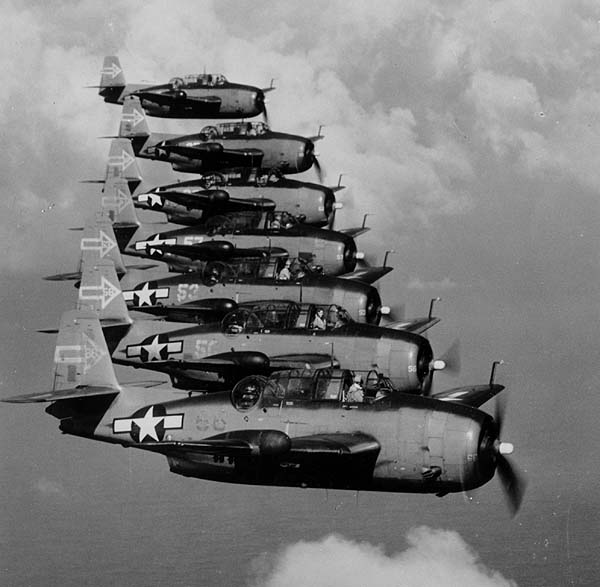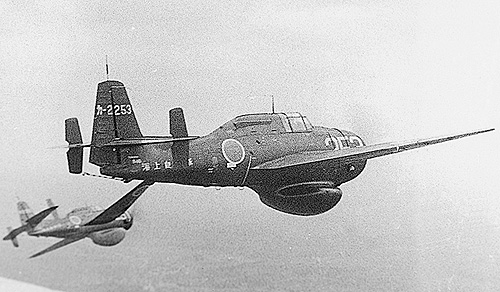
The well named "avenger", Juggernaut of retribution
The Grumman TBF Avenger is the well-remembered, massive WW2 US Navy torpedo bomber, which forged an enviable reputation as the main stick of the fleet carrier force in mosy iof the Pacific Campaign. Although not exempt of issues at first it never suffered the comparison with the ill-fated Helldiver and was beloved by its pilot. Extremely rugged, this behemoth of a plane replaced with success the Dauntless and crippled the might of the IJN until the end of the war. Coupled with the Hellcat, Grumman solidified an unprecedented credit in the USN for his war-winning design.The Avenger shared credit for sinking the Yamato and Musashi as well as many other ships (like the cruiser Mogami and man others), destroyers and even 30 submarines. Greatly modified after the war, the Avenger was well-exported and still relevant as an ASW patrol plane until the 1960s. A legendary design, that will deserve a comprehensive study.
A replacement for the Devastator

With the Vindicator, the Devastator was the main USN torpedo bomber in service on carriers of the USN until after the battle of Midway in June 1942. Developed to replaced the TBD-1, already obslolescent in 1939 the Avenger was larger, with an engine almost twice as powerful and giving a bomb bay to use an improved aerial torpedo or bombs (1,500 kg). It proved also invaluable for reconnaissance with a camera and flares, and could do precisision bombing. It was one of the best aircraft of the American air fleet, extremely rugged, powerful, reasonably protected against gunfire, and well defended by a turret and belly MG gunner, it proved reslient, a perfect complement of the equally rugged F6F Hellcat of the same manufacturer. The prototype first flew in 7 August 1941. It was introduced gradually in 1942 and replaced all older models (but not the Dauntless) at the end of 1942. It became the bedrock of the Essex class aircraft carriers as well.
The pilot was complemented by the turret and belly gunners, but both had multiple duties on board. The MG gunner was also navigator seated behind the pilot during flight, and the belly gunner was also the camera operator, and bombardier as well, responsible at aimng the bombs or torpedo on target. Although stable, reliable, and without any vice, the Avenger without escort, even with its defensive armament, was still incapable of winning a dogfight with Japanese fighters. For that reason it teamed with escorting Hellcats. Its self defense and durability were a last-ditch protection.

The beginnings of the Avenger were good: During an attack at Tulagi, May 4, 1942, before the battle of Coral Sea, they attacked the Japanese "B" invasion fleet. In 1944, the same Avengers, equipped with homing torpedoes started to attack enemy submarines and made quite a tally, starting with I-56 in the Indian Ocean. Production by Grumman, already invested with the Hellcat, was taken over by General Motors ("TBM"), and total deliveries reached 9,839 planes. The last planned TBM-4 were cancelled in late 1945. They had about forty different variants. Modifications however went on after the war and included a full modernization in the 1950s.
In addition to the USN and USMC, the Avenger was also used during WW2 by the Royal Navy, Royal Canadian Navy and Royal New Zealand Air Force, and after the war, it was exported to Brazil, Cuba, France, Japan, the Netherlands, Nicaragua, and Uruguay, seeing a lot of action until the late 1960s.
⚠ Note: This post is in writing. Completion expected in late 2022.
Design
(To come)
Production
Variants
Combat use
USN Hellcats
operators
Gallery:
















![]()
![]()

Avenger dropping a torpedo

VT-90 in flight, January 1945

British Pacific Fleet Avenger II from HMS Victorious, late 1944

USN Avenger TBM 3W prototype in 1946

RCAN Avenger ExCC ASW with MAD system, 1950

Japanese JSDMF TBM-3W in 1950
http://wp.scn.ru/en/ww2/b/565/9/1 https://alchetron.com/Grumman-TBF-Avenger http://www.wings-aviation.ch/32-FAA/2-Aircraft/Grumman-Avenger/bomber.htm
















In FAA service ()
Cold war internationl service
(Coming, this is a placeholder)Photos

Avenger dropping a torpedo

VT-90 in flight, January 1945

British Pacific Fleet Avenger II from HMS Victorious, late 1944

USN Avenger TBM 3W prototype in 1946

RCAN Avenger ExCC ASW with MAD system, 1950

Japanese JSDMF TBM-3W in 1950
Src/Read more about the xxx:
http://wp.scn.ru/en/ww2/b/565/9/1 https://alchetron.com/Grumman-TBF-Avenger http://www.wings-aviation.ch/32-FAA/2-Aircraft/Grumman-Avenger/bomber.htm
The Models Corner:
- Lohner E (1913)
- Macchi M3 (1916)
- Macchi M5 (1918)
- Ansaldo ISVA (1918)
- Sopwith Baby (1916)
- Short 184 (1916)
- Fairey Campania (1917)
- Sopwith Cuckoo (1917)
- Felixstowe F.2 (1917)
- Friedrichshafen FF 33 (1916)
- Albatros W4 (1916)
- Albatros W8 (1918)
- Hanriot HD.2
- Grigorovitch M5
- IJN Farman MF.7
- IJN Yokosho Type Mo
- Yokosho Rogou Kougata (1917)
- Yokosuka Igo-Ko (1920)
- Curtiss N9 (1916)
- Aeromarine 39
- Vought VE-7
- Douglas DT (1921)
- Boeing FB.5 (1923)
- Boeing F4B (1928)
- Vought O2U/O3U Corsair (1928)
- Blackburn Blackburn (1922)
- Supermarine Seagull (1922)
- Blackburn Ripon (1926)
- Fairey IIIF (1927)
- Fairey Seal (1930)
- LGL-32 C.1 (1927)
- Caspar U1 (1921)
- Dornier Do J Wal (1922)
- Rohrbach R-III (1924)
- Mitsubishi 1MF (1923)
- Mitsubishi B1M (1923)
- Yokosuka E1Y (1923)
- Nakajima A1N (1927)
- Nakajima E2N (1927)
- Mitsubishi B2M (1927)
- Nakajima A4N (1929)
- CANT 18
WW1
✠ K.u.K. Seefliegerkorps:
 Italian Naval Aviation
Italian Naval Aviation
 RNAS
RNAS
 Marineflieger
Marineflieger
 French Naval Aviation
French Naval Aviation
 Russian Naval Aviation
Russian Naval Aviation
 IJN Air Service
IJN Air Service
 USA
USA
Interwar
 Interwar US
Interwar US
 Interwar Britain
Interwar Britain
 Interwar France
Interwar France
 Interwar Germany
Interwar Germany
 Interwar Japan
Interwar Japan
 Interwar Italy
Interwar Italy
- Curtiss SOC seagull (1934)
- Grumman FF (1931)
- Curtiss F11C Goshawk (1932)
- Grumman F2F (1933)
- Grumman F3F (1935)
- Northrop BT-1 (1935)
- Grumman J2F Duck (1936)
- Consolidated PBY Catalina (1935)
- Brewster/NAF SBN-1 (1936)
- Curtiss SBC Helldiver (1936)
- Vought SB2U Vindicator (1936)
- Brewster F2A Buffalo (1937)
- Douglas TBD Devastator (1937)
- Vought Kingfisher (1938)
- Curtiss SO3C Seamew (1939)
- Douglas SBD Dauntless (1939)
- Grumman F4F Wildcat (1940)
- F4U Corsair (NE) (1940)
- Brewster SB2A Buccaneer (1941)
- Grumman TBF/TBM Avenger (1941)
- Consolidated TBY Sea Wolf (1941)
- Grumman F6F Hellcat (1942)
- Curtiss SB2C Helldiver (1942)
- Curtiss SC Seahawk (1944)
- Grumman F8F Bearcat (1944)
- Ryan FR-1 Fireball (1944)
- Douglas AD-1 Skyraider (1945)
Fleet Air Arm
- Fairey Swordfish (1934)
- Blackburn Shark (1934)
- Supermarine Walrus (1936)
- Fairey Seafox (1936)
- Blackburn Skua (1937)
- Short Sunderland (1937)
- Blackburn Roc (1938)
- Fairey Albacore (1940)
- Fairey Fulmar (1940)
- Grumman Martlet (1941)
- Hawker sea Hurricane (1941)
- Brewster Bermuda (1942)
- Fairey Barracuda (1943)
- Fairey Firefly (1943)
- Grumman Tarpon (1943)
- Grumman Gannet (1943)
- Supermarine seafire (1943)
- Blackburn Firebrand (1944)
- Hawker Sea Fury (1944)
IJN aviation
- Aichi D1A "Susie" (1934)
- Mitsubishi A5M "Claude" (1935)
- Nakajima A4N (1935)
- Yokosuka B4Y "Jean" (1935)
- Mitsubishi G3M "Nell" (1935)
- Nakajima E8N "Dave" (1935)
- Kawanishi E7K "Alf" (1935)
- Nakajima B5N "Kate" (1937)
- Kawanishi H6K "Mavis" (1938)
- Aichi D3A "Val" (1940)
- Mitsubishi A6M "zeke" (1940)
- Nakajima E14Y "Glen" (1941)
- Nakajima B6N "Jill" (1941)
- Mitsubishi F1M "pete" (1941)
- Aichi E13A Reisu "Jake" (1941)
- Kawanishi E15K Shiun "Norm" (1941)
- Nakajima C6N Saiun "Myrt" (1942)
- Yokosuka D4Y "Judy" (1942)
- Kyushu Q1W Tokai "Lorna" (1944)
Luftwaffe
- Arado 196 (1937)
- Me109 T (1938)
- Blohm & Voss 138 Seedrache (1940)
Italian Aviation
- Savoia-Marchetti S.55
- IMAM Ro.43/44
- CANT Z.501 Gabbiano
- CANT Z.506 Airone
- CANT Z.508
- CANT Z.511
- CANT Z.515
French Aeronavale
- GL.300 (1926-39)
- Levasseur PL.5 (1927)
- Potez 452 (1935)
- Loire 210 (1936)
- Loire 130 (1937)
- LN 401 (1938)
Soviet Naval Aviation
- Shavrov SH-2 (1928)
- Tupolev TB-1P (1931)
- Beriev MBR-2 (1930)
- Tupolev MR-6 (1933)
- Tupolev MTB-1 (1934)
- Beriev Be-2 (1936)
- Polikarpov I16 naval (1936)
- Tupolev MTB-2 (1937)
- Ilyushine DB-3T/TP (1937)
- Beriev Be-4 (1940)
-
Skoda Š-328V
R-XIII Idro
Fokker C.XI W (1934)
WW2
- De Havilland Sea Vixen
- Hawker Sea Hawk
- Supermarine Scimitar
- Blackburn Buccaneer
- Hawker Sea Harrier
- Douglas A4 Skyhawk
- Grumman F9F Panther
- Vought F8 Crusader
- McDonnell-Douglas F-4 Phantom-II
- North Am. A5 Vigilante
- TU-142
- Yak 38 forger
☢ Cold War
✧ NATO
 Fleet Air Arm
Fleet Air Arm
 US Navy
US Navy
☭ Warsaw Pact
Merch

Seafire Mark 45; HMS Pretoria Castle

Zeros vs its aversaries

Aichi D3A “Val” Junyo

Mitsubishi A5M poster

F4F wildcat

Macchi M5

SBD Dauntless Coral Sea

SBD Dauntless USS Enterprise

SBD-4 CV22